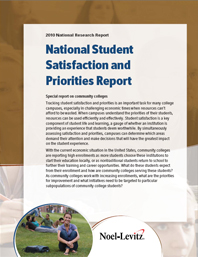enrollment
Community college students cite academic advising among their schools’ top challenges

The 2010 National Student Satisfaction and Priorities Report is now available.
The year’s report contains results from more than 745,000 students nationwide at more than 1,000 institutions, detailing how satisfied they are with their college experiences, as well as what their top priorities are. The 2010 Executive Summary focuses on the satisfaction levels of community college students and these findings stand out:
- Sixty-nine percent of students at community colleges are likely to say the institution they are attending is their first choice, a key indicator in student satisfaction.
- Students 25 years of age and older are more satisfied than traditional-age students with their experience at community colleges nationally.
- Students cite the quality of instruction and campus climate as strengths for community colleges. They listed academic advising and the availability of classes as challenges.
The perceptions of students at community colleges are important for leaders at four-year private and public institutions to monitor since these students may be transferring into four-year programs. Leaders at career schools may also find these data of interest since local community colleges may be competing for the same students as the proprietary schools. Future Executive Summaries will focus on four-year private institutions in 2011, career and private schools in 2012, and four-year public institutions in 2013.
The 2010 National Report also includes segments with national data by type of institution which reflect scale scores, national lists of strengths and challenges, and data on enrollment factors. National reports focusing on data specific to adult students, online learners, and the pilot report from the new Parent Satisfaction Survey™ are also available.
While being aware of national priorities is important, it is even more critical for the leadership of colleges and universities to understand what matters to their own students by conducting satisfaction assessments on campus and gathering data that is specific to their own student population.
If you have any strategies for assessing satisfaction, I invite you to share them in the comments. I am also happy to answer any questions you have, here or by e-mail. I will also be conducting a free Webinar, How to Assess Student Satisfaction and Priorities, on February 15. Two campus presenters will share their satisfaction assessment experiences and will elaborate on how you can apply assessment data to campus planning and improving the quality of student life and learning.
